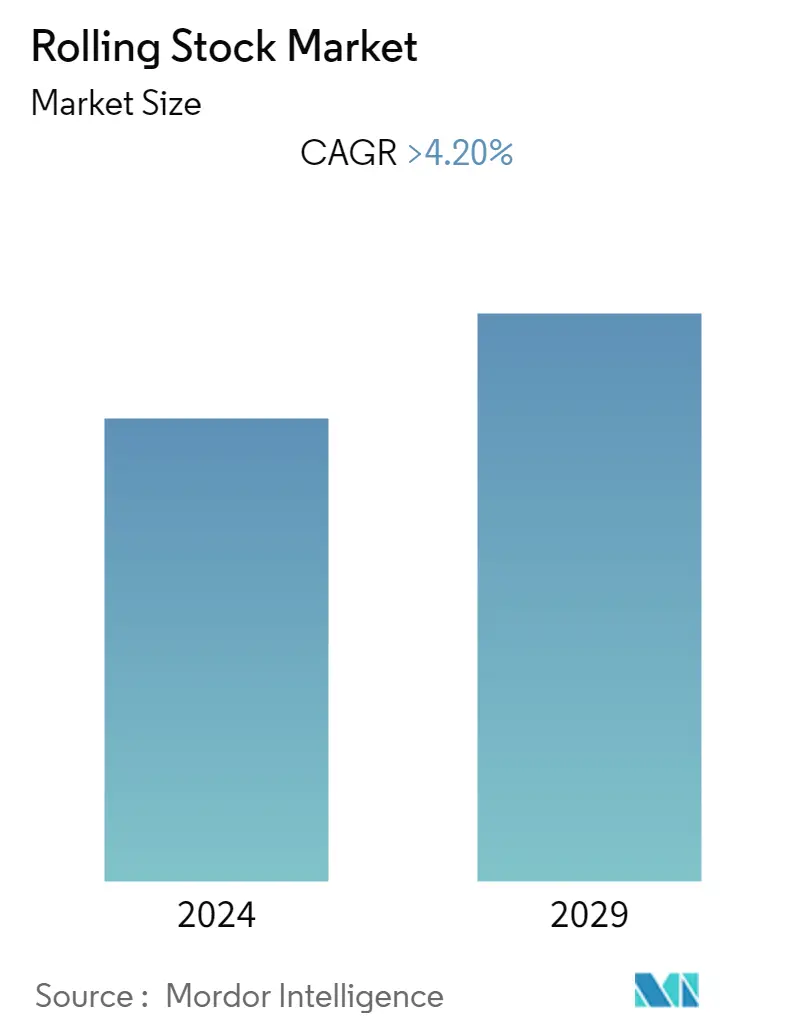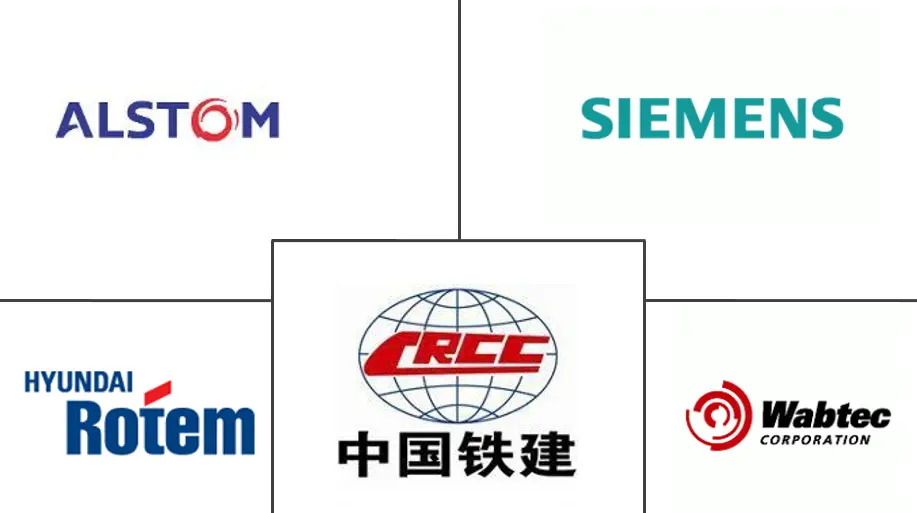Market Size of Rolling Stock Industry

| Study Period | 2019 - 2029 |
| Base Year For Estimation | 2023 |
| CAGR | > 4.20 % |
| Fastest Growing Market | Asia-Pacific |
| Largest Market | Asia-Pacific |
| Market Concentration | Medium |
Major Players
*Disclaimer: Major Players sorted in no particular order |
Need a report that reflects how COVID-19 has impacted this market and its growth?
Rolling Stock Market Analysis
The rolling stock market was valued at USD 52.5 billion in 2021, and it is expected to reach USD 67.2 billion by 2027 by registering a CAGR of over 4.2% during the forecast period (2022 - 2027).
The market was negatively impacted by COVID-19 in 2020. Travel and tourism were halted owing to the pandemic. Main rolling stock manufacturers such as Alstom (France) and Bombardier (US) stated the suspension of production owing to the supply chain bottlenecks, fall in demand, and to safeguard the safety of their employees in Spain, United States, Italy, Germany, and France, during the COVID pandemic. Furthermore, budget allotments for R&D were considerably impacted, which hampered the advancement of innovative rail development. The demand for rolling stock is mostly related to government budgets coupled with the requirement from rail operators.
Over the medium term, factors such as increasing technological advancements, growing environmental concerns, traffic congestion, and rapid urbanization are projected to drive the demand for rolling stocks during the forecast period. Furthermore, thorough innovation and research are vital to manufacturing rolling stock that is robust as the rolling stock orders have lengthened lead times and must last for a long time. This market is observing active participation from governments to make the safest and cheapest means of transportation more than comfortable.
Currently, ultra-high-speed trains and autonomous trains are the future of railway transportation, coupled with other new technologies that support it. For instance, in the Level 3 European Rail Traffic Management System (ECTS), trackside equipment will not exist. The integrity and train location will not rely on trackside equipment (axle counters, signals, track circuits); instead will be controlled by the Radio Block Centre (RBC) and train.
The European Union (EU) has the largest electrified rail length in the world, with around 218,000 km of the active rail network. EU commission is obligated to make its rail network more than convenient for passengers by establishing several laws, coupled with enticing private industry players to expand the current network. For instance, the EU commission has set a target of moving 30% of the freight traveled by more than 300 km for other modes of transport (rail or water) by 2030.
Rolling Stock Industry Segmentation
Rolling stock is generally employed for the transportation of goods, like heavy machinery, construction materials, conventional fuels, agricultural products, and so on, and passengers. The rolling stock market is segmented by type, propulsion type, and geography. By type, the market is segmented into Locomotives, Metros, Passenger Coaches, and Other Types. By propulsion type, the market is segmented into Diesel, Electric, and Electro-diesel. The report also covers the market sizes and forecasts for the Rolling stock market in 17 countries across major regions. For each segment, market sizing and forecasts have been done based on value (USD Billion).
| By Type | |
| Locomotives | |
| Metros | |
| Passenger coaches | |
| Other Types |
| By Propulsion Type | |
| Diesel | |
| Electric | |
| Electro-diesel |
| By Geography | ||||||||
| ||||||||
| ||||||||
| ||||||||
|
Rolling Stock Market Size Summary
The rolling stock market is poised for significant growth, driven by technological advancements and increasing demand for eco-friendly transportation solutions. The market, which experienced setbacks due to the COVID-19 pandemic, is recovering as governments and private entities invest in modernizing and expanding rail networks. Key players in the industry, such as CRRC, Alstom, Siemens, and Wabtec, are actively engaging in strategic acquisitions and partnerships to enhance their market presence and develop advanced rolling stock solutions. The focus on ultra-high-speed and autonomous trains, along with innovations like the European Rail Traffic Management System, underscores the industry's commitment to improving efficiency and safety in rail transportation.
Government initiatives and budget allocations play a crucial role in shaping the rolling stock market. In regions like the European Union, India, and China, substantial investments are being made to expand and upgrade rail infrastructure. The EU's efforts to shift freight transport to rail and water modes, along with India's plans to modernize its rail network, highlight the strategic importance of rolling stock in achieving sustainable transportation goals. The market's consolidation is evident through major acquisitions and collaborations, such as CRRC's acquisition of Vossloh Group and Alstom's acquisition of Bombardier Transportation, which aim to strengthen their foothold in global markets. These developments are expected to drive the rolling stock market's growth trajectory in the coming years.
Rolling Stock Market Size - Table of Contents
-
1. MARKET DYNAMICS
-
1.1 Market Drivers
-
1.2 Market Restraints
-
1.3 Porter's Five Forces Analysis
-
1.3.1 Threat of New Entrants
-
1.3.2 Bargaining Power of Buyers/Consumers
-
1.3.3 Bargaining Power of Suppliers
-
1.3.4 Threat of Substitute Products
-
1.3.5 Intensity of Competitive Rivalry
-
-
-
2. MARKET SEGMENTATION
-
2.1 By Type
-
2.1.1 Locomotives
-
2.1.2 Metros
-
2.1.3 Passenger coaches
-
2.1.4 Other Types
-
-
2.2 By Propulsion Type
-
2.2.1 Diesel
-
2.2.2 Electric
-
2.2.3 Electro-diesel
-
-
2.3 By Geography
-
2.3.1 North America
-
2.3.1.1 United States
-
2.3.1.2 Canada
-
2.3.1.3 Rest of North America
-
-
2.3.2 Europe
-
2.3.2.1 Germany
-
2.3.2.2 United Kingdom
-
2.3.2.3 France
-
2.3.2.4 Italy
-
2.3.2.5 Spain
-
2.3.2.6 Rest of Europe
-
-
2.3.3 Asia-Pacific
-
2.3.3.1 India
-
2.3.3.2 China
-
2.3.3.3 Japan
-
2.3.3.4 South Korea
-
2.3.3.5 Rest of Asia-Pacific
-
-
2.3.4 Rest of the World
-
2.3.4.1 Brazil
-
2.3.4.2 United Arab Emirates
-
2.3.4.3 Other Countries
-
-
-
Rolling Stock Market Size FAQs
What is the current Rolling Stock Market size?
The Rolling Stock Market is projected to register a CAGR of greater than 4.20% during the forecast period (2024-2029)
Who are the key players in Rolling Stock Market?
CRRC Corporation Limited, Alstom SA, Siemens AG, Wabtec Corporation and Kawasaki Heavy Industries Ltd. are the major companies operating in the Rolling Stock Market.

